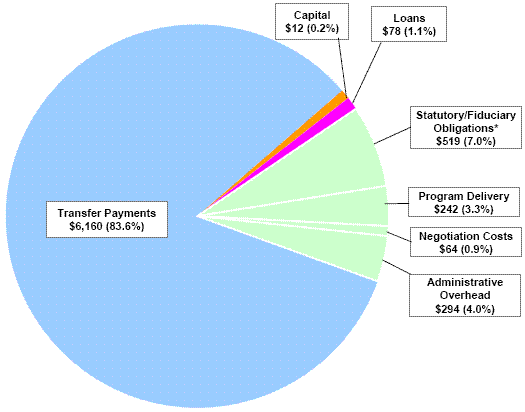Archived - Backgrounder - Aboriginal Affairs and Northern Development Canada's Financial Picture
Archived information
This Web page has been archived on the Web. Archived information is provided for reference, research or record keeping purposes. It is not subject to the Government of Canada Web Standards and has not been altered or updated since it was archived. Please contact us to request a format other than those available.
Aboriginal Affairs and Northern Development Canada (AANDC) is one of numerous federal departments and agencies that deliver programs and services to First Nations, Inuit, Métis and people living in Canada's North. These programs play an important role in building strong, viable communities and improving the quality of life for Aboriginal people and Northerners.
AANDC is responsible for the majority of federal programs and services that support Aboriginal people and Northerners. In the 2011-2012 Main Estimates report tabled in Parliament, AANDC will spend approximately $7.4 billion (see chart below). Of this, approximately 85 per cent goes directly to recipients through transfer payments. Much of this funding ensures that Aboriginal people have access to basic services comparable to those provided to other Canadians through provincial, municipal and territorial governments. These services include education, housing, community infrastructure (water and sewage systems), social support services, and other benefits.
The cost of basic services is driven by a young and growing population. In fact, the population of Status Indians on reserve has a higher proportion of youth (under 24 years old) than the population of Canada as a whole. This creates a growing demand for basic services with overall price increases of approximately 4% per year for the Department.
Since 1997-1998, funding for essential programs and services provided by the Department have been subject to a 2% escalator. It should be noted that this does not apply to other AANDC program areas, such as the negotiation and settlement of claims, litigation or Northern Affairs.
Historical Expenditure Profile
Over the period from 2006-2007 to 2011-2012, AANDC's expenditures increased from $6.1 billion to $7.4 billion, an average annual increase of about 3.7%. This growth in expenditures reflects increased ongoing demand for essential programs and services. However, other factors have contributed to this increase as well. The Department has been assigned additional duties in recent years. These include operations related to the Office of Residential Schools Resolution, Aboriginal Business Canada, and the Office of the Federal Interlocutor. The growth in spending can also be attributed to an increased focus on the settlement of claims and a targeted approach to long-term investments through recent federal budgets.
While the Department has taken on more responsibilities, its administrative overhead has remained relatively stable at about four per cent of its budget.
Capitalizing on Efficiencies
The Department is taking steps to operate more efficiently and better execute its mandate. For example, AANDC is actively investing in sectoral tripartite agreements, particularly in the areas of education and child and family services. These agreements allow the Department to draw on provincial government expertise, while building greater understanding of the unique needs and circumstances of a diverse Aboriginal population. The Department is also relieving the reporting burden of First Nations communities by implementing a new federal policy on transfer payments. It has also introduced a new Default Prevention and Management Policy to provide a range of support and tools to communities that default in their funding agreement with AANDC.
Getting Results
As AANDC moves forward, it will continue to take a more targeted approach to expenditures for Aboriginal people and Northerners, by focusing on structural reforms and increasing the effectiveness of long-term investments. In trying to find practical solutions to real issues, work will continue with willing partners to renovate programs and develop innovative approaches in the areas of market-based housing, education partnerships and economic development. Maximizing the value of our investments in these areas will have a significant and positive impact on improving the quality of life for Aboriginal people and Northerners.

2011-12 Main Estimates - $7,368 million
This image of the pie chart is showing the breakdown of departmental expenditures for 2011-2012. The breakdown is shown as follows: $6,160 million (83.6%) in Transfer Payments; $519 million (7.0%) for statutory/fiduciary obligations; $242 million (3.3%) for program delivery; $64 million (0.9%) for negotiation costs; and $294 million (4.0%) for administrative overhead; $78 million (1.1%) in Loans; and $12 million (0.2%) in Capital.
It should be noted that the major item under statutory/fiduciary obligations of $519M is $391M for obligations stemming from the Indian Residential Schools Settlement Agreement (comprised of $360M for the Independent Assessment Process and $31M in other support). Furthermore, of the $519M, over $300M is for direct payments to recipients including obligations stemming from the Indian Residential Schools Settlement Agreement, claims related obligations, Department of Justice costs, out-of-court settlements, etc. Figures may not add due to rounding.
Figures may not add due to rounding.